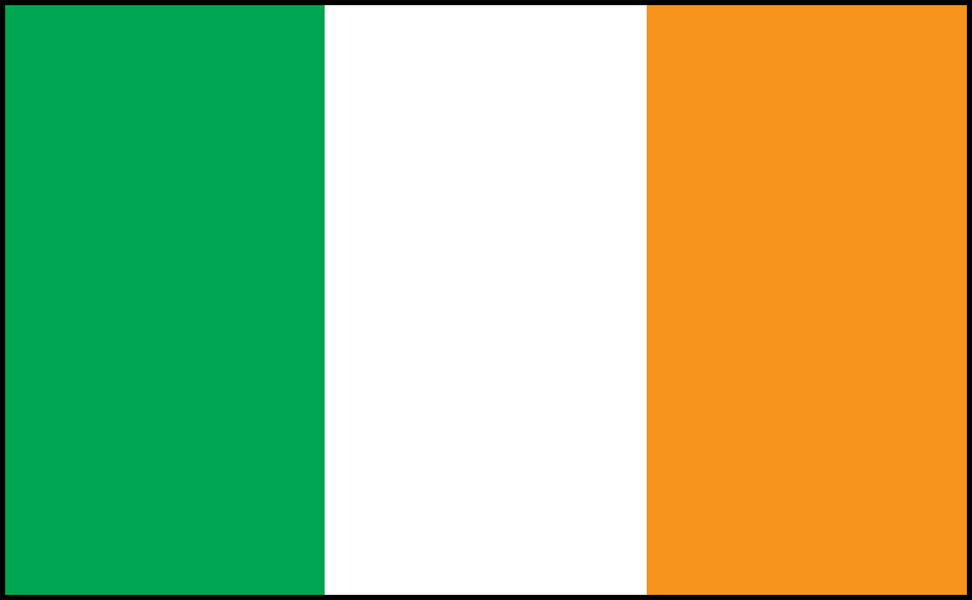Interesting Ireland Facts
Ireland is a coastal country located in Northern Europe where it is bordered by the United Kingdom, the Atlantic Ocean and Irish Sea. It spreads over 70,273 km2 of land. The overall population of Ireland is somewhere in the region of 4,761,657.
Find out interesting Ireland facts and information about this European country with our fact file for kids. Explore important facts about the population, location, size, climate, currency, flag, continent, language, people, culture, geography, landscape and landmarks of Ireland.
Discover Europe with our interesting Ireland facts for kids based on questions such as: What continent is Ireland in? What is Ireland famous for? How big is Ireland? What color is the flag of Ireland? What is the main language of Ireland?
Ireland Fact File: Continent: Europe * Country Name(s): Ireland * Location: Northern Europe * Bordering: the United Kingdom, the Atlantic Ocean and Irish Sea * Capital City: Dublin * Size: 70,273 km2 * Estimated Population: over 4,761,657 * Currency: Euro (EUR) * Language(s): English and Irish * Country Code: +353
Interesting Ireland Facts for Kids
Interesting Facts for Kids 1: Size & location facts
Ireland forms part of the continent of Europe, where it has a coastal position and is bordered by the United Kingdom, the Atlantic Ocean and Irish Sea. There are seven continents in the world: Asia, Africa, North America, South America, Europe, Antarctica, Australia (Oceania). Europe is the world's second smallest continent, occupying a total area of 10,180,000 km2. Europe has 51 countries, with some countries belonging to both Europe and Asia, and forms 6.8% of the world's landmass. Ireland is a coastal country that encompasses a total area of approximately 70,273 km2. It is one of Europe's smaller countries. The Republic of Ireland shares the same island as Northern Ireland which is part of the United Kingdom.
Interesting Facts for Kids 2: Population facts
The population of this European country is in excess of 4,761,657 people. The majority of Ireland's inhabitants reside in Dublin which is the country's most populous city. Ireland has an average population when compared to most other countries across the world, its overall population density is approximately 65 people per sq km. The estimated population of Europe is approximately 738,442,000 inhabitants, making it the continent with the second smallest population in the world. The continents in order of population, starting with highest population first, are: Asia, Africa, North America, South America, Europe, Australia (Oceania Region) and Antarctica. The total population of the entire world is in excess of 7.6 billion people.
Interesting Facts for Kids 3: Capital & major cities
The capital city of Ireland is Dublin. Other major cities located in this country include Cork, Dún Laoghaire, Limerick, Galway and Tallaght.
Interesting Facts for Kids 4: Country borders
The following details provide a guide to Ireland's approximate border lengths:
Coastline 1,448 km, UK 443 km.
Interesting Facts for Kids 5: Climate and geography facts
Ireland has a temperate climate characterized by overcast, mild conditions. The summer is generally cool and the winter season is usually mild, with temperatures being moderated by the North Atlantic Current. The geography of Ireland consists of rolling plains, flatland and hilly areas, low mountainous areas and coastal regions. The lowest point of Ireland is the Atlantic Ocean at 0m, and the highest point of elevation is Carrauntoohil at 1,041m.
Interesting Facts for Kids 6: Natural Resources of Ireland
Natural resources can be defined as materials and substances that occur naturally on Earth. Natural resources are very important across the world, and can be exploited for economic gain. The level of natural resources present in an individual country depends on varying factors which are influenced by the geography, climate and location of that country. Some countries, such as Russia, The United States, Saudi Arabia and Canada, have many natural resources, where as some other countries have limited to none. Food, construction and transport are three primary examples of uses of natural resources. The following information provides examples of these uses: fish occurs naturally in streams, rivers, lakes and oceans, and can be caught for food consumption. Wood/timber can be extracted from forests for construction purposes, i.e. to build homes and furniture. Crude oils can be refined into different kinds of fuels in order to power vehicles/cars. The natural resources of Ireland include natural gas, peat, copper, zinc, lead, silver, barite, gypsum, limestone and dolomite.
Interesting Facts for Kids 7: Language facts
The official languages of Ireland are English and Irish. The Irish language is also known as Gaelic or Gaeilge, and it is spoken by approximately 40 percent of the population, particularly on the western coast of Ireland.
Interesting Facts for Kids 8: Religion facts
The main religion of Ireland is Roman Catholic at approximately 78% of the population. The rest of the population either belongs to other religions or no religion at all.
Interesting Facts for Kids 9: Symbols of Ireland
Each country has its own individual culture, history and identity. Flags, emblems, symbols, mottos, colors, anthems and songs represent the national pride and identity of countries worldwide. These national symbols are created through the unique history of a nation and can portray both hardship and prosperity, embodying freedom, strength and unity. Flags, emblems, colors, songs and mottos reflect the past, present and future aspirations of a country, and create an important image to the rest of the world. National symbols can represent a combination of things that are important to a country such as birds, animals, plants, geographical features, tools of agriculture, crops, and tools of war. The following facts depict some of the national symbols, songs and colors that are important to Ireland:
National symbol(s): harp, shamrock (trefoil)
National colors: blue and green
National Anthem/Song: Amhran na bhFiann (Translation: The Soldier's Song)
National Holiday(s): Saint Patrick's Day, 17 March
